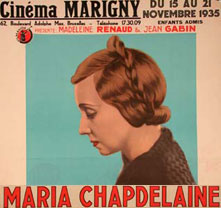Maria Chapdelaine
-

Poster for the film Maria Chapdelaine (Julien Duvivier, 1934).
Source : Cinémathèque québécoise, 1988.2299.AF
From Novel to Film: Maria Chapdelaine
Louis Hémon’s Maria Chapdelaine was first published in serial form in a Parisian newspaper in 1914, and then in Quebec as a novel in 1916. Its reputation grew and in a few years it was a bestseller in French-speaking countries. It achieved worldwide success when it was translated into English in 1921.
In 1934, Julien Duvivier, profiting from the novel’s immense success, adapted it to film. It was a sound business decision. But Duvivier also wanted to make Quebec and its culture known in France, to turn the film into “a tribute to the valour of the French-Canadian race”.
A Difficult Production
In mid-March 1934 Duvivier, accompanied by his cinematographer, arrived in Quebec to shoot the film’s winter scenes in the Péribonka region. He had no luck, however: it didn’t snow and the extreme cold often froze the camera. The snowstorm essential to the story was eventually filmed in a Parisian studio. While in Quebec, Duvivier was invited to Montreal by Robert Hurel, the founder of France-Film, the film’s distributor in Quebec.
Four months later, on 12 July, Duvivier and his troupe arrived in Quebec City. They spent the next three weeks in the Péribonka region shooting outdoor scenes, in addition to a few scenes shot in Montreal and Quebec City. All the major roles were played by French actors. Madeleine Renaud and Jean Gabin played the unfortunate couple. Only Fred Barry, a famous Quebec actor, had a solid, albeit minor role, making it possible to put his name in big letters on posters for the film in Quebec.
Most of the interiors were shot in France, with furniture that was often completely unlike the furniture found in Quebec, something critics complained about.
An Enthusiastic Reception
The premiere of Maria Chapdelaine in Quebec took place in Montreal and Quebec City on 5 January 1935. The night before, Quebec premier Louis-Alexandre Taschereau and a variety of other political figures attended an advance screening. The film immediately drew large crowds, and continued to do so, earning more money than any French film before it in Quebec.
Critics too were enthusiastic. They admired the film’s faithfulness to the novel, its respect for Catholic morality and beliefs, the patriotism of the priest, the film’s dramatic effects, the natural beauty of the country, the use of folkloric songs and the acting of most of the cast. Critics pointed out that the dialogues were sometimes inauthentic: they lacked “local spirit”. People made fun of the characters’ accents and lamented the occasional anachronism and error, such as harvesting blueberries in a field of daisies.
Another adaptation of Maria Chapdelaine was shot in France and Great Britain by the French director Marc Allégret in 1950. Gilles Carle made the first Quebec version in 1983.